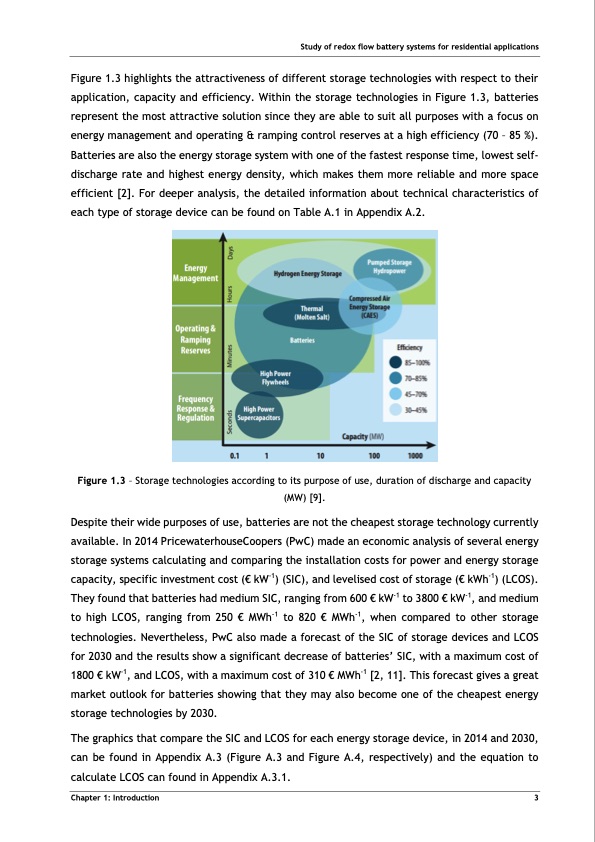
PDF Publication Title:
Text from PDF Page: 014
Study of redox flow battery systems for residential applications Figure 1.3 highlights the attractiveness of different storage technologies with respect to their application, capacity and efficiency. Within the storage technologies in Figure 1.3, batteries represent the most attractive solution since they are able to suit all purposes with a focus on energy management and operating & ramping control reserves at a high efficiency (70 – 85 %). Batteries are also the energy storage system with one of the fastest response time, lowest self- discharge rate and highest energy density, which makes them more reliable and more space efficient [2]. For deeper analysis, the detailed information about technical characteristics of each type of storage device can be found on Table A.1 in Appendix A.2. Figure 1.3 – Storage technologies according to its purpose of use, duration of discharge and capacity (MW) [9]. Despite their wide purposes of use, batteries are not the cheapest storage technology currently available. In 2014 PricewaterhouseCoopers (PwC) made an economic analysis of several energy storage systems calculating and comparing the installation costs for power and energy storage capacity, specific investment cost (€ kW-1) (SIC), and levelised cost of storage (€ kWh-1) (LCOS). They found that batteries had medium SIC, ranging from 600 € kW-1 to 3800 € kW-1, and medium to high LCOS, ranging from 250 € MWh-1 to 820 € MWh-1, when compared to other storage technologies. Nevertheless, PwC also made a forecast of the SIC of storage devices and LCOS for 2030 and the results show a significant decrease of batteries’ SIC, with a maximum cost of 1800 € kW-1, and LCOS, with a maximum cost of 310 € MWh-1 [2, 11]. This forecast gives a great market outlook for batteries showing that they may also become one of the cheapest energy storage technologies by 2030. The graphics that compare the SIC and LCOS for each energy storage device, in 2014 and 2030, can be found in Appendix A.3 (Figure A.3 and Figure A.4, respectively) and the equation to calculate LCOS can found in Appendix A.3.1. Chapter 1: Introduction 3PDF Image | Tubular Vanadium Air Redox‐flow battery

PDF Search Title:
Tubular Vanadium Air Redox‐flow batteryOriginal File Name Searched:
204521.pdfDIY PDF Search: Google It | Yahoo | Bing
Salgenx Redox Flow Battery Technology: Salt water flow battery technology with low cost and great energy density that can be used for power storage and thermal storage. Let us de-risk your production using our license. Our aqueous flow battery is less cost than Tesla Megapack and available faster. Redox flow battery. No membrane needed like with Vanadium, or Bromine. Salgenx flow battery
| CONTACT TEL: 608-238-6001 Email: greg@salgenx.com | RSS | AMP |